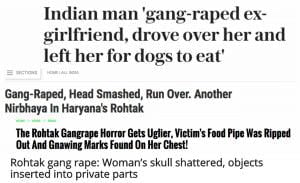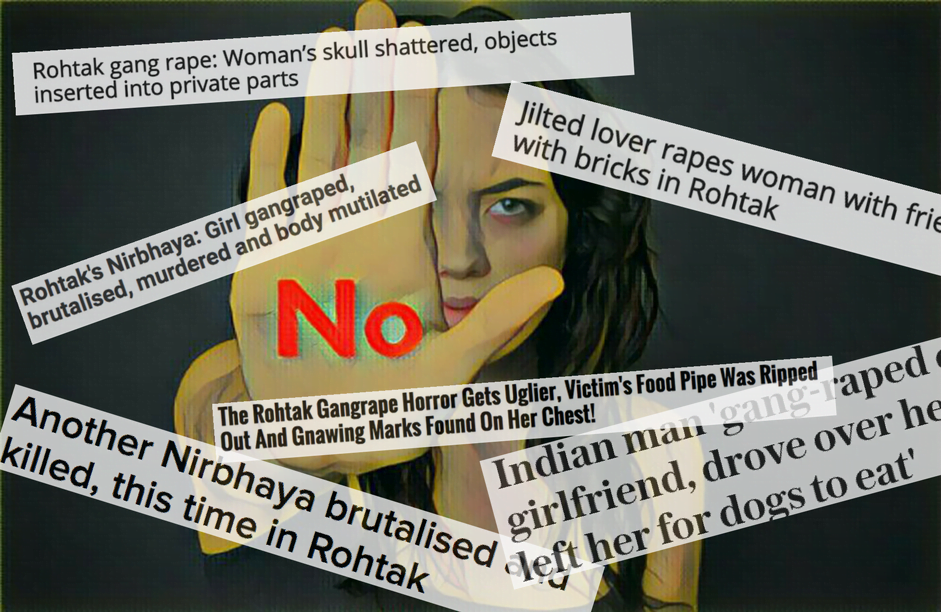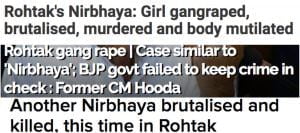The Rohtak gang rape case, where a 23 year old woman was brutally raped has brought with it a lot of media attention. While outrage, shock, and media reportage of the case are quite warranted, the sensationalist headlines and the victim-blaming language used by some media houses needs to be called out.
In our campaign titled #GBVinMedia, we have previously analyzed reportage of the sexual violence and how it often reflects the rape culture that engenders such brutal acts of violence against women. Rape cases are often sensationalized – gory details scream out of headlines as though vying with one another for the most brutal depiction of the crime. Why is the fact that a woman has been raped not brutal enough? Such gruesome portrayal turns the crime into a media circus and creates a farce out of the tragedy.
This article by a BBC reporter analyses rape reportage in Indian media post December 2012. She concludes that while coverage of rape has increased after the Delhi case, the narratives of rape reportage have become less sensitive and sympathetic.
Here are some of the ways in which the media has failed the victim and her family in its portrayal of the Rohtak gang rape case.
1. Headlines Screaming Sensationalism

These are headlines from The Telegraph, NDTV, India Times and Hindustan Times respectively.
As this Newslaundry piece suggests, the headlines are reminiscent of TV producers trying to increase TRP ratings. Just reporting rape seems to be passé, and these newspaper headlines seem to be vying with each other to increase the element of shock and outrage. The India Times headline even ends with an exclamation point! The theatrical tone is hard to miss in these sensationalist headlines.
What this sort of reportage does is turn rape into a circus. All it succeeds in doing is creating shock and outrage, and the baying for blood and the death penalty for these rapists. It does not succeed in creating the sorely-needed discussion on the harmful attitudes that engender this constant violence against women in our country, or on real solutions to them.
The frenzied fear that it creates only reinforces harmful and protectionist attitudes towards women, wherein the only solution to these sorts of crimes becomes to keep women locked in for their own safety.
2. Reinforcing The Victimhood Of Women Through Images

These are the images used in the articles reporting this rape in Zee News, Rediff News and American Bazaar respectively.
What’s in common with these images? They portray women cowering, hiding, or being violently silenced. What stereotypes do these images propagate? That women are helpless victims. What effect do these stereotypes cause? Women being further infantilised and restricted in the name of “protection”.
We need to change the way that rape is visualised in news media. These images center the narrative around women in positions of victimhood, instead of in positions of survival. They always focus on the victim’s fear, trauma, and helplessness instead of the crime of the perpetrator, fetishizing the position of victimhood for a rape survivor.
This reinforces the sentiment that women are absolutely doomed, with no life beyond rape, with no chance to fight back, and with no recourse for further help – all extremely damaging stereotypes that deeply harm the lives of rape survivors. Also, these pictures could be triggering to rape survivors in the way that they depict the act.
3. The Repeated Usage of the Term ‘Jilted Lover’

While only the Hindustan Times article chose to display the term in its headline, other newsrooms like NDTV and American Bazaar and used the term in the body of the text. The term ‘jilted lover’ recharacterizes a violent criminal as a lovelorn Romeo. It grants some justification for his crime. It also reinforces a victim-blaming attitude – “If she hadn’t rejected him, maybe she would not have fallen victim to such a horrific crime.”
The act of rape is an act of violence and domination. Terms like ‘jilted lover’ romanticize the act. They perpetuate the rape culture that engendered this crime in the first place. They reinforce ideas of male entitlement – that enforcing horrific modes of revenge are normal responses to rejection, and thus, the onus must fall on the woman to protect herself from such acts. It condemns a woman for refusing consent.
4. Victim-Blaming Language and Irrelevant Details
The Indian Express, Times Of India, The Tribune and The Gulf Today chose to furnish the detail of the victim’s marital status of being a divorcee, despite it having no bearing on the case. The irrelevant detail however, does further serve to shame the victim – the stigma of divorce in India is well-known. It also furnishes revealing and private information about her identity, which is not only illegal as per Section 228A of the Indian Penal Code, but also deeply unethical.
The Times Of India also mentions that the perpetrator “also suspected her of having an affair with another man” – another unnecessary detail that reinforces the language of victim-blaming and casts unfair and unnecessary aspersions about the woman.
5. Constant Comparison with “Nirbhaya”
The constant comparison of this rape with the 2012 rape of Jyoti Singh Pandey has been hard to miss. “Another Nirbhaya!” screams one headline after another. The headlines above have been taken from India Today, DNA, and Times of India respectively.
The comparison with “Nirbhaya” is presumably due to the degree of brutality present in this rape case. However, by setting Nirbhaya as the yardstick by which all future rapes are going to be judged, the media is going down a very dangerous path. It sends out the message that only rapes that are as brutal as the 2012 Delhi gang rape and murder case are worthy of news sensationalism and an outpouring of support. It desensitises the public to rape cases because now, only the “most brutal” ones become newsworthy. This trivialises other rapes, deeming them not as worthy of garnering public support.
It also lumps the Rohtak rape case with that of Jyoti’s, without giving it the independent reportage it deserves. It becomes “another Nirbhaya” – as Newslaundry says, “old anger in a new bottle”. Nothing new to see here folks, you can move on.
All rapes are brutal. All rape victims and survivors deserve our outrage, our support and our empathy. Setting Nirbhaya as a standard dilutes this message. The Rohtak case is its own case. The victim is not just another footnote in the symbolic epithet that the term Nirbhaya has now become.
6. Displaying Partially Blurred Images Of The Victim

India Today
Section 228A of the Indian Penal Code states that the disclosure of the name, or any identifiable details of victims of rape is strictly illegal. An article by India Today published a partially blurred image of the victim (only her face is blurred – the rest of her torso is visible), which might lead to the identity of the victim becoming known. This picture, along with other details carelessly shared by mainstream media, all together supply a plethora of information by which the victim may be identified.
This is perhaps the most irresponsible manner in which this rape case has been reported, displaying a flagrant insensitivity to the victim and her family. Media ethics need to be taken more seriously, especially during rape reportage which is such a sensitive topic.
The consumption of media which reinforces victim-blaming attitudes, which displays no sensitivity toward’s the family’s plight, and which salaciously sensationalises rape only serves to engender a rape culture in our society – which births sexual violence against women. It is time we become more discerning about the way in which news is presented to us, and it is definitely time for news media to adopt a more responsible attitude towards the portrayal of gender-based violence.
Authored by Asmita Ghosh, with inputs from Shriya Das.
Featured Image Credit: Breakthrough India [modified from original]
About the author(s)
Feminism In India is an award-winning digital intersectional feminist media organisation to learn, educate and develop a feminist sensibility and unravel the F-word among the youth in India.





